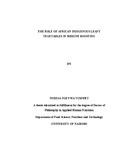| dc.description.abstract | The immune system is a collection of biological processes within an organism that
protects against disease. A healthy/strong immune system ensures that one is less
susceptible to infections and ill health. Factors affecting the proper functioning of
the immune system are many and they include micronutrient deficiencies,
infections, illnesses, major burns, medications and emotional and physical stress.
Micronutrient deficiencies are of concern worldwide and especially in the
developing countries. The main deficiencies of public health importance are
Vitamin A, iron, iodine and zinc. African Indigenous Leafy Vegetables are very
rich in vitamins, minerals and other nutrients. There have been allegations of
immunity boosting of individuals with infections, particularly HIV infection,
through consumption of different indigenous vegetables such as spiderplant,
African nightshade, stinging nettle and amaranthus. This study investigates the
contribution of African Indigenous Leafy Vegetables in immune boosting using
immune suppressed white albino laboratory rats.
A structured questionnaire and focused group discussions were used to document
the diversity of African Indigenous Leafy Vegetables in the study area, Maseno
division of Kisumu West district, and to rank them according to immune boosting
and health claims, and popularity in terms of production and consumption in
comparison with literature. The three African Indigenous Leafy Vegetables
VIII
significant in terms of contributing to healthy functioning of the body, immune
boosting and good nutrition amaranth (Amaranthus hybridus), African nightshade
(Solanum nigrum)and spiderplant (Gynandropsis gynandra) were further studied.
They were planted at a plot in the College of Agriculture and Veterinary Sciences,
University of Nairobi and nutritional value in terms of beta carotene, ascorbic acid,
and minerals iron, zinc, copper, magnesium, manganese and calcium determined at
both vegetative and flowering stages. Different vegetable preparation methods
standardized from the communities’ practices were also employed and the
nutrients compared in these different methods across the three AILVs. The
preparation methods were boiling for 5 minutes, boiling for 5 minutes and a
further 3 minutes with milk, frying for 5 minutes, frying for 10 minutes and raw.
The eight nutrients of immune boosting importance mentioned earlier were
determined. The contribution of African Indigenous Leafy Vegetables to immune
boosting was investigated using immune suppressed White Albino rats by
measuring C-reactive protein, CD3%, T-Killer cells, CD+4 counts and CD+8
counts. In this, thirty female albino rats were divided into four groups A, B, C and
D. The immunity of groups A, B and C was suppressed using Cyclosporine A,
thereafter groups A and B were given raw and cooked A. hybridus respectively.
Group C was the positive control while group D was the negative control.
IX
The results of the survey confirm that there is diversity of AILVs in the study area
with nine such vegetables. Three of these were rich in the eight selected
micronutrients and were therefore studied further. The vitamin content of the
vegetables reduced with flowering while mineral content increased. Amaranthus
hybridus was in overall of higher nutritional value than Solanum nigrum and
Gynandropsis gynandra and boiling or steaming for five minutes was the best
cooking method for nutrient retention. Amaranthus hybridus boosted the immunity
of White albino rats as was seen in the ratio of CD+4/CD+8 counts. | en_US |

